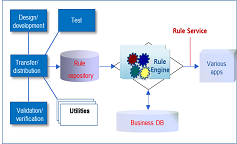We will learn about the basic concepts and ideas related to BRMS (business rule management system) as well as the concept of business rule.


-
What is Business Rule?

Every company has guidelines for controlling various decisions required in business operations. Business policies are documents that state these guidelines, while business rules are the detailed specifications of the concrete conditions, environments, and actions to help people make decisions that are aligned with the business policies. Therefore, business rules are based on the business procedures, corporate policies, government regulations, business experience, and knowledge.

-
Why BRMS ?

BRMS is a dedicated platform for the integrated management of business rules, which are separated from applications. The biggest reason for separating business rules from applications is that the application life cycle (ALC) and the rule life cycle (RLC) have mutually heterogeneous natures, and it is inefficient and difficult to synchronize them in real time.

-
Components of BRMS

BRMS is an organic combination of the various software components required to enable the constant development, test, management, transfer, operation, and maintenance of business rules in the business operation environment.
- Utilization of Rules & BRMS
-
In many cases, the efforts to utilize business rules remain in the domain of point solution. How can the potential values of business rules and BRMS be realized at the corporate level?

- Extended BRMS Platform: BPM, EP & Predictive Analysis
-
The BRMS can provide the various decision making services required at the corporate level by integrating BPM (business process management), EP (event processing), analytics, and other technical features, with the BRMS as the focal point.

- Operation of Knowledge, Automation of Decision Making, and Business Agility
-
In the future, such knowledge and intelligence should be extracted, externalized, and operationalized in a way that is more applicable to the business operations.















